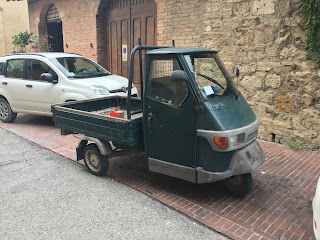He’s been in and out of sports cars for nearly a half
century. Now the car trips are usually shorter duration, invariably hauling
something, the vehicle sitting in parking public parking lots for minutes or
hours. A nice sport car gets attention, sometimes too much, having being keyed by
some entitled tool full of wealth bias. And it scrapes the front on so many
driveways. This 2017 Porsche Macan GTS is easy to get in and out of, it blends in, kind of, in the current landscape of utility vehicles.
It hauls loads and butt. It offers easy cargo access and for those hauling
infants and toddlers, easy access to car seats. Yet it’s also the old man’s
sports car. Big 21” wheels and tires with Porsche tuned suspension and handling
will embarrass or hang with numerous performance cars existing today in any
handling or braking metric. Could this be the best all-around vehicle on the
road? The crossover, essentially a raised station wagon, is a do-it-all
vehicle.
The Macan GTS is powered by a twin turbo V-6 that produces
360 horsepower and 369 lbs feet of torque channeled through the Porsche dual
clutch transmission (PDK). Coupled with torque
vectoring all-wheel drive, Car and Driver tested it to a 13.0 second quarter
mile at 105mph. Despite the 4492lb weight, it posted a spectacular breaking
distance of 157 feet from 70mph. Granted the weight has an effect on the
mileage rating of 17mpg city and 23mpg highway. The packaging is impressive,
allowing for a 19.8 gallon fuel tank for less fill-ups, very convenient.
The acceleration has a nice mechanical, kind of a spinning
sound, very refined with snappy upshifts. Typical of Porsche, the handling is
confidence inspiring and feels like a taller sports car but without the
expected slop of a high ground clearance SUV/CUV. The ride is very comfortable with the air
suspension dampers and not hampered by the 21” wheels with 265/45 tires in the
front and 295/35 tires in the rear along with Porsche Active Suspension
Management which lowers the ride height 10mm versus the standard Macan.
There are nice touches typical of Porsche, even with a lot
of buttons surrounding the shifter. This example has the sport chrono package,
heated front and rear seats, panoramic sunroof and keyless entry and drive.
Having had a series of Porsches, the most recent a 2015 Cayman GTS previously
reviewed, one of the surprises is the perfect Bluetooth acoustics and voice
command system. Equating it to an acoustic enclosure, the noise cancellation
and transmission is said to be spectacular.
The navigation screen also has a cool touch to zoom in or
out feature but it does leave fingerprints. And navigation summary provided on
the 3rd gauge directly in front of the driver is very convenient. Also
the home screen in the main display is configurable with the desired
information, such as music, time/date, recent calls, navigation, etc. There is
a rear parking camera and forward proximity sensors to aid in parking. The
infotainment system is very well thought out but including Apple Car Play would be the next step feature
wise.
The cargo capacity is good with the rear seats up, but not
great. Two people headed to the golf course means taking a larger SUV or folding
down the three-sectional rear seats. However looking underneath the cover reveals
a temporary spare. However the orange colored wheel is probably to entice you
to get it replaced or fixed immediately.
The exterior is well styled, the red calipers a nice touch
behind the turbo-style wheels. A close look at the front grill reveals the
louvered opening that open and closes for the cooling efficiency of the
radiator. Further inspection along the nicely aggressive front clip shows other
cooling radiators. Porsche had headlight styling down to a science and
interestingly the hood is somewhat of a clamshell with openings for the
headlights and integrated vents that direct intake are to the air boxes,
creating a seal with the hood. Very clever and the entire set-up actual makes
it one of the few SUV/CUVs that show well. Yes, I mean at a car show.
It’s not perfect, but it’s close for overall utility, sport
and practicality. The fuel efficiency isn’t great, the rating is 17 mpg city
and 23 highway and the effortless acceleration will trend that downard. Doing build on the
Porsche configurator, a power tilt and telescoping steering wheel didn’t seem
to be available, but the owner has no issues with it, not needing to use it for
ingress and egress.
If your use cycle is frequent loading and unloading or even
children in car seats, but want something compact versus overly large for
around-town use and frequent parking lot visits, a crossover utility vehicle is a great choice. But when the
cargo is unloaded, or dropped off at daycare, what’s wrong with having a decent
handling driver with 13 or even 12 second quarter mile capability? It’s about
having the best of both worlds. Add the capability, engineering and performance
of a Porsche, it’s tough to beat a Macan GTS, although there are a couple of
higher horsepower models of 400hp and 440hp each...
38 photos here: https://www.facebook.com/media/set/?set=a.1239082409529801.1073741930.378354382269279&type=1&l=93a147d1ff
38 photos here: https://www.facebook.com/media/set/?set=a.1239082409529801.1073741930.378354382269279&type=1&l=93a147d1ff




































